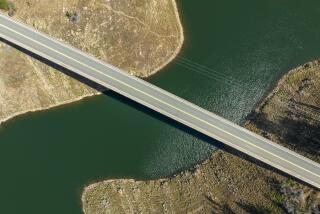Deukmejian Orders Draft of Emergency Drought Plan
- Share via
SACRAMENTO — Noting that California “is headed for its driest summer in more than a decade,” Gov. George Deukmejian disclosed Saturday that he has ordered the drafting of contingency plans for a “drought emergency” and urged residents to take voluntary steps to conserve water.
The governor also proposed spending an additional $10.3 million to beef up state firefighting forces, warning that a hazardous fire season is “one of the most devastating consequences” of dry conditions.
According to state water officials, this is only the third time this century that California has experienced two consecutive critically dry winters.
“Over the years, California has developed an excellent water policy to serve the needs of our entire state,” Deukmejian said during his weekly radio address. “I am hopeful that with conservation and common sense we can weather the drought conditions facing our state in the months ahead.”
The governor said he instructed Water Resources Director David N. Kennedy to “take the lead” in developing a statewide plan to conserve water, which would include voluntary efforts by agriculture, local government, business and industry. The soon-to-be-drafted drought emergency plan would take effect “in the event that the water situation in our state worsens,” Deukmejian added.
Among other efforts, the governor said the public should take steps such as repairing leaking faucets, using garbage disposals sparingly, washing only full loads of laundry and dishes and watering lawns and plants in the evening or the early morning hours.
Deukmejian noted that during 1977, the state’s last drought year, Californians saved a total of 1 million acre feet of water through such efforts--enough to supply water to 4.5 million people for a year.
A number of counties and water agencies throughout California have already taken independent actions to conserve water.
Agriculture-rich San Joaquin Valley, one the hardest-hit areas of the state, declared a local state of emergency and requested loans from the U.S. Department of Agriculture to help ranchers provide feed for their livestock. Several other agricultural communities of the Central Valley have instituted mandatory water rationing intended to cut use by up to 50%.
More than 3 million water customers in San Francisco and the East Bay may soon face similar water cutbacks of up to 25% under rationing plans being developed by local utility companies.
In Los Angeles, the Department of Water and Power has announced a voluntary effort to reduce consumption by 10%. Ironically, arid Southern California is generally in better shape than the usually water-rich north since much of the water used in the south comes from the Colorado River.
Water Resources Director Kennedy said through a spokesman that the state has already begun working on its water conservation plan and is scheduled to hold workshops next month to help local water agencies develop their own strategies to save water.
Kennedy, however, gave no indication of what might be included in the drought contingency plan his department is drafting.
Fire Season’s Early Start
The governor’s proposal to spend an additional $10.3 million on firefighting efforts is primarily the result of state fire officials’ declaration earlier this month of the start of the fire season in 17 counties--the earliest date in recent memory that such a declaration has been issued. The order covers all of Southern California.
Kevin Brett, Deukmejian’s press secretary, said $5.1 million is needed to cover the cost of seasonal firefighters for the rest of the fiscal year, which ends June 30. The remainder of the $10.3 million is proposed for the 1988-89 fiscal year to add an additional permanent firefighter to each fire engine operated by the Department of Forestry. Both proposals require approval by the Legislature.
Deukmejian said his Administration also plans to add four new state prison inmate firefighting camps in Northern California to the 31 already in operation.
So far this season, 1,200 wild land fires have been reported in California, 20% more than normal.
“While we will be doing all we can at the state level to brace for a hazardous fire season, all Californians must help in this effort,” Deukmejian said.
More to Read
Sign up for Essential California
The most important California stories and recommendations in your inbox every morning.
You may occasionally receive promotional content from the Los Angeles Times.










